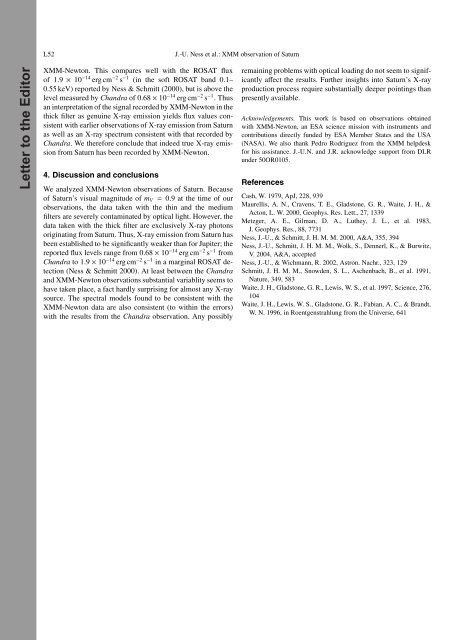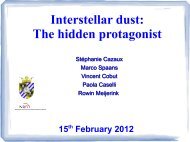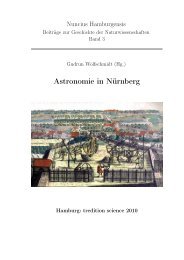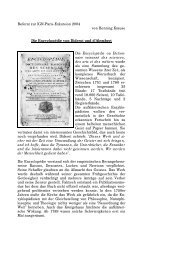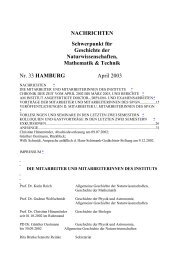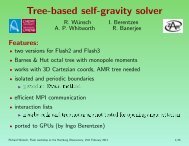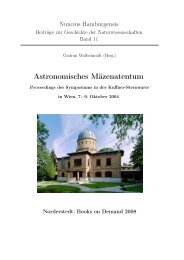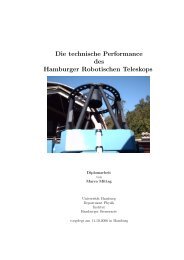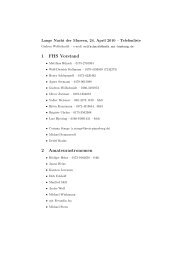pdf version - Hamburger Sternwarte - Universität Hamburg
pdf version - Hamburger Sternwarte - Universität Hamburg
pdf version - Hamburger Sternwarte - Universität Hamburg
You also want an ePaper? Increase the reach of your titles
YUMPU automatically turns print PDFs into web optimized ePapers that Google loves.
L52<br />
J.-U. Ness et al.: XMM observation of Saturn<br />
Letter to the Editor<br />
XMM-Newton. This compares well with the ROSAT flux<br />
of 1.9 × 10 −14 erg cm −2 s −1 (in the soft ROSAT band 0.1–<br />
0.55 keV) reported by Ness & Schmitt (2000), but is above the<br />
level measured by Chandra of 0.68 × 10 −14 erg cm −2 s −1 . Thus<br />
an interpretation of the signal recorded by XMM-Newton in the<br />
thick filter as genuine X-ray emission yields flux values consistent<br />
with earlier observations of X-ray emission from Saturn<br />
as well as an X-ray spectrum consistent with that recorded by<br />
Chandra. We therefore conclude that indeed true X-ray emission<br />
from Saturn has been recorded by XMM-Newton.<br />
4. Discussion and conclusions<br />
We analyzed XMM-Newton observations of Saturn. Because<br />
of Saturn’s visual magnitude of m V = 0.9 at the time of our<br />
observations, the data taken with the thin and the medium<br />
filters are severely contaminated by optical light. However, the<br />
data taken with the thick filter are exclusively X-ray photons<br />
originating from Saturn. Thus, X-ray emission from Saturn has<br />
been established to be significantly weaker than for Jupiter; the<br />
reported flux levels range from 0.68 × 10 −14 erg cm −2 s −1 from<br />
Chandra to 1.9 × 10 −14 erg cm −2 s −1 in a marginal ROSAT detection<br />
(Ness & Schmitt 2000). At least between the Chandra<br />
and XMM-Newton observations substantial variablity seems to<br />
have taken place, a fact hardly surprising for almost any X-ray<br />
source. The spectral models found to be consistent with the<br />
XMM-Newton data are also consistent (to within the errors)<br />
with the results from the Chandra observation. Any possibly<br />
remaining problems with optical loading do not seem to significantly<br />
affect the results. Further insights into Saturn’s X-ray<br />
production process require substantially deeper pointings than<br />
presently available.<br />
Acknowledgements. This work is based on observations obtained<br />
with XMM-Newton, an ESA science mission with instruments and<br />
contributions directly funded by ESA Member States and the USA<br />
(NASA). We also thank Pedro Rodriguez from the XMM helpdesk<br />
for his assistance. J.-U.N. and J.R. acknowledge support from DLR<br />
under 50OR0105.<br />
References<br />
Cash, W. 1979, ApJ, 228, 939<br />
Maurellis, A. N., Cravens, T. E., Gladstone, G. R., Waite, J. H., &<br />
Acton, L. W. 2000, Geophys. Res. Lett., 27, 1339<br />
Metzger, A. E., Gilman, D. A., Luthey, J. L., et al. 1983,<br />
J. Geophys. Res., 88, 7731<br />
Ness, J.-U., & Schmitt, J. H. M. M. 2000, A&A, 355, 394<br />
Ness, J.-U., Schmitt, J. H. M. M., Wolk, S., Dennerl, K., & Burwitz,<br />
V. 2004, A&A, accepted<br />
Ness, J.-U., & Wichmann, R. 2002, Astron. Nachr., 323, 129<br />
Schmitt, J. H. M. M., Snowden, S. L., Aschenbach, B., et al. 1991,<br />
Nature, 349, 583<br />
Waite, J. H., Gladstone, G. R., Lewis, W. S., et al. 1997, Science, 276,<br />
104<br />
Waite, J. H., Lewis, W. S., Gladstone, G. R., Fabian, A. C., & Brandt,<br />
W. N. 1996, in Roentgenstrahlung from the Universe, 641


